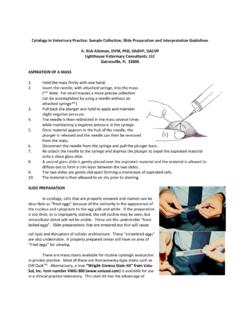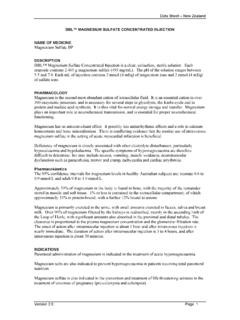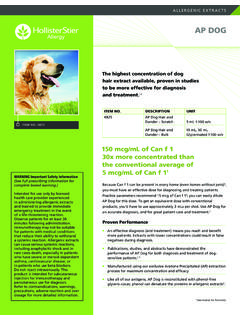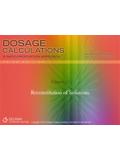Transcription of SEDATION AND ANALGESIA IN BIRDS
1 SEDATION AND ANALGESIA IN BIRDS Christoph Mans, Dr. med. vet., DACZM University of Wisconsin, School of Veterinary Medicine 2015 Linden Drive, Madison, WI 53706, USA SEDATION of dogs and cats in veterinary practice is daily routine for a variety of procedures, such as radiographs and ultrasonography, or other non-painful but potentially stressful procedures. However, historically for avian patients, either manual restraint of conscious BIRDS or general anesthesia is typically performed in order to complete most clinical procedures. General anesthesia predisposes BIRDS to cardiovascular and respiratory depression, and may cause aspiration of gastric or crop contents and hypothermia.
2 In contrast, manual restraint in conscious BIRDS is simple to perform, but can have negative consequences. These can include stress to the bird and/or handler, negative conditioning to the clinic environment ( , the person restraining or the towel used for restraint), hyperthermia, and the predisposition of trauma to the handler and/or bird . Several recent studies demonstrated that manual restraint of BIRDS causes increased body temperature and respiratory In sick, old, or very stressed bird , acute collapse and death secondary to manually restraint have been reported. Therefore, SEDATION techniques provide a useful alternative for reducing physiologic stress in BIRDS undergoing non-painful clinical procedures.
3 Further, SEDATION in BIRDS provides easier restraint and increases the safety of many clinical procedures ( blood collection, radiography, ultrasonography) and allows for a more complete examination, which would otherwise only be achieved under general anesthesia. Using safe and effective sedative protocols in pet BIRDS provides substantial benefits to the patients as well as the veterinarian and staff, and should be considered for a variety of clinical procedures. Route of Drug Administration Historically sedative drugs have been most commonly administered by intramuscular injection in BIRDS . Recently the intranasal administration of sedative drugs in BIRDS has gained increased attention.
4 Intranasal administration of midazolam in Hispaniolan Amazon parrots, ring-necked parakeets, budgerigars and canary finches resulted in rapid onset of dose-dependent degree SEDATION , which is completely reversible with intranasal Intranasal drug administration offers an alternative, non-invasive technique for drug administration in BIRDS (Table 1). It is characterized by its ease of administration, high bioavailability, rapid onset of action, and reduced pain compared to intramuscular administration. Elevation of muscle enzymes in biochemistry panels secondary to intramuscular drug administration is avoided, if intranasal administration is used instead.
5 In addition, clients perceive the intranasal route as non-invasive, compared to intramuscular injection, which leads to better client compliance in cases in which SEDATION is recommended. The time of onset to SEDATION is rapid, typically within 3 - 5 However, limitations of intranasal administration can include incomplete drug delivery, due to sneezing during administration, physiologically narrowed nostrils ( cockatoos) or upper respiratory disease ( blocked or stenotic nostrils). In some cases, in larger BIRDS ( macaws) the drug volume can also be limiting the effectiveness and can produce excessive sneezing, therefore leading to incomplete drug delivery.
6 More highly concentrated drugs ( midazolam 50 mg/ml, Zoopharm, Windsor, CO) are available, but intramuscular administration might be more feasible in these cases. Intramuscular administration Intranasal administration Pro Reliable drug delivery Faster administration Non-invasive & not painful Higher client acceptance Reduced risk of needles stick injury No changes in the biochemical panel Con Invasive Potentially painful Possible post-injection hemorrhage Changes in the biochemical panel Risk of incomplete drug delivery Difficult to administer larger volumes May cause sneezing More difficult in BIRDS with feathered nares Table 1: Comparison of intramuscular and intranasal drug administration in pet BIRDS Drugs used for SEDATION Midazolam is currently the most commonly used drug for SEDATION of pet BIRDS and has a wide margin of safety.
7 Midazolam has sedative, muscle relaxing, anxiolytic, amnestic and appetite stimulating properties in ,5,6 The injectable form of midazolam (midazolam hydrochloride (5 mg/ml); Hospira Inc, Lake Forest, IL) or a more concentrated form (50 mg/ml, Zoopharm, Windsor, CO) can be administered intranasally and intramuscular, without side Dosages commonly used in pet BIRDS range from - 3 At the University of Wisconsin, we routinely use 2 mg/kg of midazolam in pet BIRDS , if administered intranasally and as the sole sedative agent. In smaller BIRDS such as finches or budgerigars we routinely use 4-6 mg/kg of midazolam if administered alone. Diazepam is of similar efficacy as midazolam in BIRDS following intranasal administration, but has a longer onset time and duration of ,4 While less commonly used for intranasal administration in BIRDS , diazepam represents a suitable alternative, in cases in which midazolam might not be available.
8 The intramuscular administration of diazepam should be avoided, due to delayed absorption and muscle Dosages commonly used in pet BIRDS range from - 2 mg/kg, if used as a sole sedative agent. Dosages as high as 10-15 mg/kg have been administered to finches and budgerigars, without significant side ,4 Butorphanol is the currently the most commonly used opioid analgesic in BIRDS . Besides its analgesic effects, butorphanol has sedative effects, which are potentiated by benzodiazepines ( midazolam, diazepam). The combined administration of midazolam and butorphanol is recommended in BIRDS for which midazolam alone provides an insufficient level of SEDATION , or which require deeper SEDATION for certain clinical procedures such as radiographic positioning.
9 Butorphanol can be given in combination with midazolam, drawn into a single syringe and can be given parenterally as well as intranasally. No side effects of intranasal administration of butorphanol at a dose range of 1 - 3 mg/kg are seen in psittacine _ENREF_5At the University of Wisconsin we routinely use butorphanol 1 - 2 mg/kg combined with 2 mg/kg of midazolam in pet BIRDS administered intranasally or by intramuscular injection. Reversal of SEDATION Reversal of SEDATION in pet BIRDS will depend on the patient and the purpose of SEDATION . SEDATION performed in order to facilitate physical examination and diagnostic sample collection should always be reversed, in order to have the patient return to normal behavior and food intake as soon as possible.
10 It is important not to discharge sedated patients, as owners do not tend to appreciate having a partially sedated bird , which might be imbalanced, sleepy and refuse to eat. BIRDS that underwent SEDATION for e-collar or bandage placement, or that were sedated for control of seizures, should not be reversed. In these cases, BIRDS should be carefully monitored and reversal considered if the level of SEDATION is perceived too deep, or the duration of SEDATION is prolonged and might interfere with physiological behavior, particularly food intake. Flumazenil is a benzodiazepine antagonist, and is used to reverse the sedative effects of midazolam and diazepam in ,2,7 The injectable form of flumazenil (flumazenil hydrochloride ( mg/ml), Abaxis Pharmaceutical Products, Schaumburg, IL) can be administered intranasally, intramuscularly or intravenously, without side effects.









